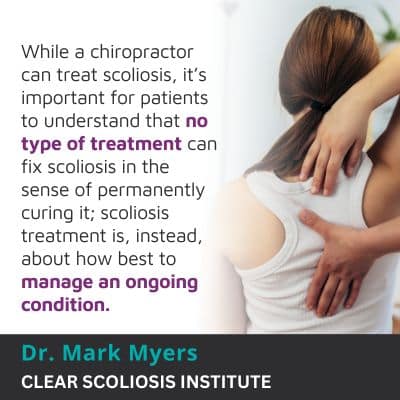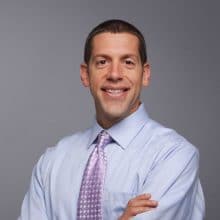![Can A Chiropractor Treat Scoliosis? [What You Should Know] Image](https://clear-institute.org/wp-content/uploads/2024/04/scoliosis-chiropractor.jpg)
What patients should know about being diagnosed with scoliosis is that the way a diagnosis is responded to can have far-reaching effects. Treatment results can never be guaranteed, but particularly with early detection, a chiropractic-centered treatment approach can have a number of benefits.
As a progressive condition, scoliosis can’t technically be cured because its nature will always be to get worse over time; however, when chiropractic care is scoliosis-specific and combined with other types of treatment, it can be highly treatable.
Before getting to the specifics of what chiropractors can do for scoliosis patients, let’s start with being diagnosed as this is where a patient’s scoliosis-journey begins.
Scoliosis is a complex spinal condition, so patients recently diagnosed have a lot to learn about their condition, including how to treat it and lead a scoliosis-friendly lifestyle.
Being diagnosed with scoliosis means an unhealthy and unnatural spinal curve has developed; scoliotic curves bend unnaturally to the side and also rotate, making scoliosis a 3-dimensional condition.
Being diagnosed with scoliosis also means being diagnosed with a progressive condition whose nature is to get worse over time, and this means the size of the unnatural spinal curve is going to increase, causing symptoms to become more noticeable, and making the condition more complex to treat.
As a progressive condition, scoliosis can’t be fixed or cured; patients have to understand that when considering different treatment options.

When patients recently diagnosed with scoliosis ask if it can be fixed, they tend to mean cured, and the answer is that the condition’s nature is always going to be about getting worse over time; treatment has to be constantly working towards counteracting that nature.
So scoliosis requires ongoing care and management (treatment), but it can’t be fixed as in permanently cured and no longer requiring treatment.
Treating scoliosis involves symptom management and improving quality of life by impacting the condition on different levels, and while there are different ways to treat scoliosis, a modern conservative chiropractic-centered approach is what patients of the CLEAR Scoliosis Institute benefit from.
When it comes to the goal of conservative scoliosis treatment, that includes reducing the size of the scoliotic curve so as much of the spine’s healthy curves as possible can be restored, and treating scoliosis effectively for long-term results doesn’t just involve the spine, but also the spine’s surroundings, and brain-body communication.
No one type of treatment on its own is enough to impact scoliosis the way a multi-faceted scoliosis-specific treatment plan can, and this is where the distinction between general chiropractic care and scoliosis-specific chiropractic care is important.
The complex nature of the 3-dimensional spinal condition is beyond the scope of general chiropractic and requires the specialized training of a scoliosis-specific chiropractor.
General chiropractic care tends to focus on joint immobility and improving that immobility by manipulating joints to become unstuck, so to speak, but with scoliosis, the issue is more about joint location than mobility.
General chiropractic care can miss the mark with scoliotic spines by actually increasing pressure on the joints of the spine, which can aggravate the spine’s surrounding muscles and nerves and cause scoliosis to progress faster.
As scoliosis develops and progresses, the vertebrae (bones of the spine) at the unnatural curve’s apex are becoming more tilted over time, and this is changing their position in relation to the other vertebral bodies, causing the spine to become misaligned and disrupting its overall biomechanics.
Chiropractic care for scoliosis is more about repositioning those excessively-tilted vertebrae so the spine’s alignment is improved, but effective treatment has to involve a lot more than just repositioning tilted vertebrae.
In order for effective long-term management of scoliosis, the spine’s surroundings also have to be impacted, as does brain-body communication.

Chiropractic care can involve a number of techniques and manual adjustments that can alter the structure of the spine by repositioning its most-tilted vertebrae.
Addressing areas of vertebral subluxation doesn’t just affect the health of the spine, but also its surrounding muscles and nerves, which brings us to additional important facets of scoliosis treatment.
The health of the spine’s surrounding muscles are key when it comes to spinal support and stabilization; increasing core strength through physical therapy and a number of scoliosis-specific exercises and stretches can mean the spine’s receiving the support it needs to be able to maintain its healthy curves and alignment.
In addition, muscles need to be relaxed and balanced, and a variety of therapies can help with this, and retraining the brain to use the spine’s surrounding muscles and joints differently can also be achieved through the use of massage, exercises, stretches, and physical therapy.
When these different facets of treatment are being applied simultaneously, they can complement one another for the best potential results.
In addition, while there are never treatment guarantees, a scoliosis chiropractor can assess a scoliotic spine to gauge how much improvement can be worked towards.
Each case of scoliosis is unique, and this is why treatment plans designed by specialists are so important.
Not only does scoliosis range widely in severity from mild to severe, there are also different types of scoliosis a person can develop, and different types and severity levels have different treatment needs.
In addition, scoliosis affects all ages and can develop in any of the spine’s main sections, or in more than one as a combined scoliosis, and different curvature locations and curvature types/patterns are known to affect the body differently.
With a condition that’s so variable, conservative treatment providers need to be trained in multiple treatment modalities to ensure conditions can be impacted on every level, as is necessary for the sustainability of treatment results.
As a CLEAR-certified scoliosis chiropractor, I have an in-depth understanding of spinal biomechanics and scoliosis, and I comprehensively assess the health of each patient’s spine so potential treatment success can be gauged and worked towards through the customization of treatment plans.
Spinal Rigidity
As scoliosis progresses, spinal rigidity increases, and this is a factor that shapes how responsive a spine can be to treatment; that’s not to say a spine that’s experienced significant progression can’t be treated, it just means that some preparatory work might be necessary to increase a patient’s level of spinal flexibility prior to starting manual adjustments.
Assessing spinal health doesn’t just involve its discs, bones, and muscles; it also involves the spinal nerves and the amount of tension they’re being exposed to.
Adverse spinal nerve tension is thought to be a potential contributing factor in the development of idiopathic scoliosis, and it also shapes a patient’s potential quality of life.
So assessing a patient’s spinal rigidity is a key part of treating scoliosis; I need to know a patient’s level of spinal flexibility before treatment is started, and throughout, to ensure improvements are being made, and making sure the spine is actually ready for treatment is also important when it comes to potential treatment plan efficacy.
Sensorimotor Integration
Sensorimotor integration is a term that references how well the brain communicates with the rest of the body; remember, the brain and spinal cord together to form the central nervous system (CNS), which is why spinal conditions can be disruptive to brain-body communication.
Treating scoliosis doesn't just mean working towards repositioning the spine, but also retraining the brain to use the spine differently, and assessing a patient’s sensorimotor integration commonly involves a series of balanced-related tests to gauge how aligned and balanced the spine and body are before the onset of treatment.
These balance tests are repeated during different stages of treatment to assess how the the body and spine are responding and treatment can be adjusted accordingly.
So scoliosis-specific chiropractic care applied as part of a conservative treatment approach has the potential to change the position of the spine and improve the health of its surrounding muscles and nerves, while improving sensorimotor integration for better communication between the brain, the spine, the spine’s surroundings, and the rest of the body.
When all of these aspects of treatment come together, they can impact a person’s spinal strength, flexibility, and function, while core strength is increased so the spine’s healthier position can be supported and stabilized, tension on spinal nerves is reduced, and enhanced brain-body communication can mean improvements to posture and body positioning.
No single type of treatment is powerful enough to treat scoliosis effectively, but an approach that integrates multiple scoliosis-specific treatment disciplines has the potential to impact conditions on multiple levels.
While traditional scoliosis treatment offers a surgical response, modern conservative treatment is chiropractic-centered and offers a less-invasive treatment option with proven results.
What I want patients and their families to know about chiropractic care for scoliosis is that it has to be scoliosis-specific, not general; general chiropractic care can help with increasing spinal flexibility and short-term pain management, but when it comes to corrective results, this is beyond the scope of general chiropractic and requires additional types of conservative treatment.
When condition-specific chiropractic care is combined with a variety of therapies including scoliosis-specific exercises and stretches, corrective results can be achieved; corrective results mean the spine’s position and health have been improved, along with the health and function of the spine’s surrounding muscles, nerves, and overall sensorimotor function.

CLEAR provides a unique and innovative way of understanding scoliosis. Sign up to receive facts and information you won’t find anywhere else.
